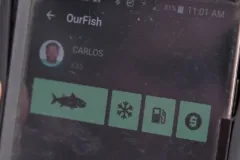There’s an App for That: Using Phones to Help Make Fishing Sustainable

There’s an app for everything these days. Many of our modern-day problems can be matched with modern-day technology. So, when looking at the issue of overfishing—especially for local, artisanal fishers—scientists from Smithsonian’s Marine Conservation Program decided to make use of some of that technology.
Fish populations around the world are in trouble. They’re threatened by overfishing, loss of habitat, and climate change. Not only is this bad for the fish and ocean ecosystems, but for all the communities of people, many in developing countries in the tropics, who rely on fish for protein and livelihoods. The fisheries in these communities are especially hard to manage because so many species are caught.
Research has proven that Marine Protected Areas (or MPAs for short) are one of the best ways to ensure that fish are caught sustainably, particularly when many species need to be protected at once. MPAs restrict fishing in particular areas and allow for fish to replenish their numbers. Researchers have found that in many areas fish populations are actually bouncing back due to these protections.
But setting up marine reserves is not as easy as it seems.
The first decision of many must be where the exact boundaries of a reserve should go. Then the hard work of talking with local communities and local politicians must happen, since these areas usually have to be designated with legislation. Often the hardest part is maintaining the reserve over time and making sure fishermen support protection of the area and enforce the boundaries.
To first tackle the problem, Marine Conservation Program researchers need accurate data that provides insight on where fish are and, more importantly, where they aren’t. By collecting tissue samples from fish in different areas over time, researchers like Courtney Cox, a marine conservation researcher associated with the Smithsonian, can track where they start out and where they end up as fully-grown healthy adults. “Once we figure out where they live, we can identify where to set up reserves,” Cox explains.
Then the Program sends out teams to talk to local communities, including fishermen, local authorities, and businesses.
This is where the technology comes in.
Many of these fishermen have smart phones, so scientists developed a Fish App to help fishermen track their catches. It’s an easy, effective way to record fish data since almost all the fishermen and buyers already have phones.
Fishermen started recording numbers, sizes, and species of fish that were being caught using simple icons on the phone app. With this information Steve Canty, the Program Coordinator of the Marine Conservation Program, can know exactly what fish are being caught and from that information, build a database.
The data used to be collected on paper by fish buyers and information was often incomplete and inaccurate, so not very effective. “The fish app makes it easy,” Canty says, and the scientists found fishermen were more likely to provide accurate information with the app.
Another technological tool that researchers use are GPS trackers on fishing boats, which allows them to keep track of who is fishing where and link this information to what they are catching. All of this information is collected digitally, helping them track the changing nature of fish stocks in real-time.
This is all vital information for establishing and maintaining a marine reserve, but it is much more than that. The information is also good for business, and for the fisherman, who benefit by having precise information on how much they are earning day to day. They are able to make better decisions on where to fish and how to improve the quality of their catches.
The data researchers like Cox and Canty are collecting can also be used to measure economic growth in these communities and across nations. This is important because the artisanal fishers in these communities represent a large proportion of the total fishing that occurs globally.
In Honduras and Belize over 4,000 small-scale fishers are licensed in the new system, and now feel empowered to take ownership in conservation efforts. The app is taking hold in other places as well. This means we can apply this approach to many communities from Africa to SE Asia—to help fish stocks rebound around the world. That’s good news for the fish and the people that depend on them.
This story was made possible by a grant from the Smithsonian Women's Committee. http://swc.si.edu/about-grants


